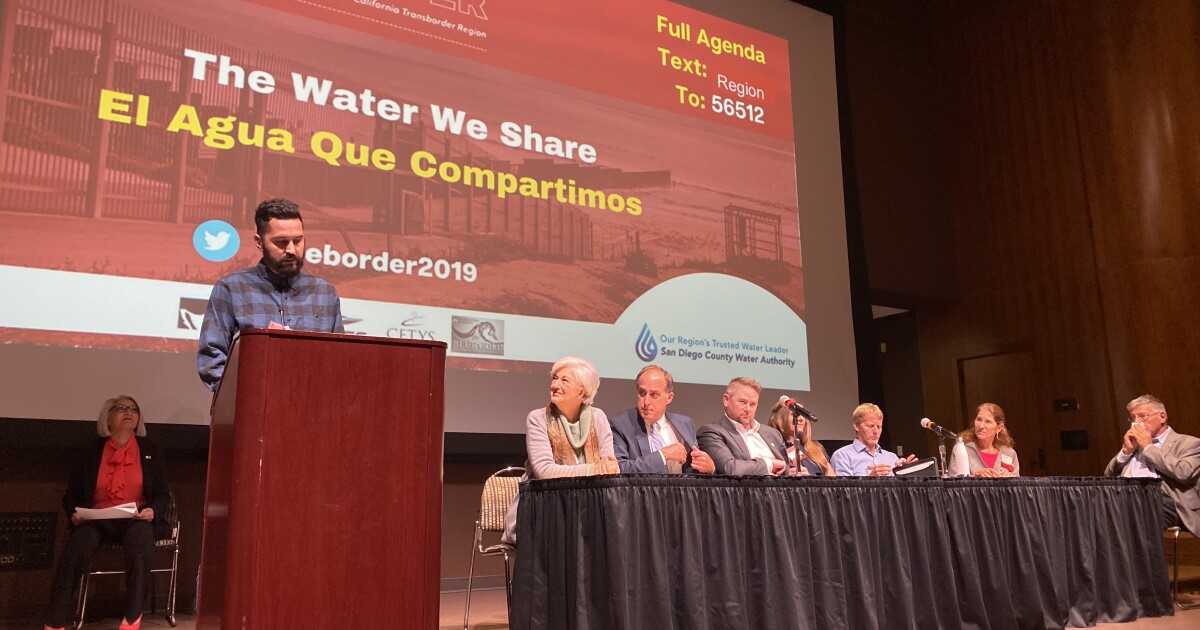
A bi-national conference held Monday at San Diego State University was aimed at analyzing water resources in the Baja California and San Diego border region where challenges include cross-border pollution and water scarcity, experts said.
Water supplies are particularly low in Tijuana right now where officials announced earlier this month citywide roving water shutoffs for the next two months to allow an important reservoir to replenish.
The water shutoffs have been rotating to different neighborhoods every day with the goal of a 24-hour shutoff every five days in each neighborhood to spread the burden throughout the city.
Experts at the Reborder 2019 conference discussed ways to improve regional access to “a secure and reliable water supply” through wastewater treatment and desalination.
Advertisement
Former San Diego Mayor Jerry Sanders, who moderated one of the panels, asked each of the speakers to identify what the single biggest challenge with water is for the entire region. Sanders is the current president and CEO of the San Diego Regional Chamber of Commerce, which organized the event.
“In my opinion, the most pressing challenge for water in the trans-border region is an over-dependence on the Colorado River for water supply and a diminishing snow pack and rainfall,” said Peter MacLaggan, the senior vice president of California project development at Poseidon Water, a seawater desalination developer that runs a desal plant in Carlsbad.
SDSU hosted the first part of the two-day conference. Tuesday’s portion will be held at the Universidad Autonoma de Baja California in Tijuana.
The conference entitled “The Water We Share” and “El Agua Que Compartimos” included sessions from academic experts at SDSU and UABC, and public policy experts and industry experts.
Advertisement
It also included students who contributed artwork like posters and poems recited at different times throughout the day.
San Diego State graduate student Brent Ameneyro, who spent some of his childhood in Puebla, a city southeast of Mexico City, shared a poem he wrote about what it was like growing up with water as an extremely scarce resource.
Ameneyro compared the water delivery man in Mexico to the ice cream delivery man in the United States, illustrating how precious a resource water is to children who grow up south of the border.
Laura Silvan, the president of the Proyecto Fronterizo de Educacion Ambiental, a civil association in Tijuana aimed at protecting oceans and monitoring water quality, said the water issues facing the San Diego area are relative.
Silvan said about 12 percent of the population in Tijuana regularly does not have access to running water in their homes, and the city’s water supply is 99 percent dependent on the Colorado River. She said, despite that, the border city is recognized throughout Mexico for good water management practices.
“In the case of Tijuana, being adjacent to the United States, we are very fortunate because these challenges which might be invisible for anyone south of us, (instead) everyone in these two rooms are working to address them,” said Silvan.
Regional experts also spoke about sewage from a treatment plant in Tijuana that washes into the United States through the Pacific Ocean, often closing beaches in Imperial Beach and Coronado.
Faye Crevoshay, the communications and policy director of Wildcoast, an international environmental nonprofit, said plastic and tires also wash across the border and into the ocean.
Advertisement
Crevoshay said her organization has been working on a plan to treat the sewage water in Tijuana and transport it to the Valle de Guadalupe wine region in Baja California to be used for irrigation.
“There is also a tsunami of plastic coming into the Tijuana River Valley, so we are trying to put a boon in Tijuana to stop the plastic before it flows into the Tijuana River watershed,” said Crevoshay.
Alan Sweedler from SDSU’s Center for Energy Studies said more public awareness is needed.
“I think what is going to change this is an uproar. A real uproar. That this is just intolerable for an industrialized society to be dealing with these issues,” said Sweedler.
"water" - Google News
November 26, 2019 at 07:56AM
https://ift.tt/33kNVds
Bi-national conference tackles border region's water issues - The San Diego Union-Tribune
"water" - Google News
https://ift.tt/2XpCTT3
Shoes Man Tutorial
Pos News Update
Meme Update
Korean Entertainment News
Japan News Update
Bagikan Berita Ini















0 Response to "Bi-national conference tackles border region's water issues - The San Diego Union-Tribune"
Post a Comment